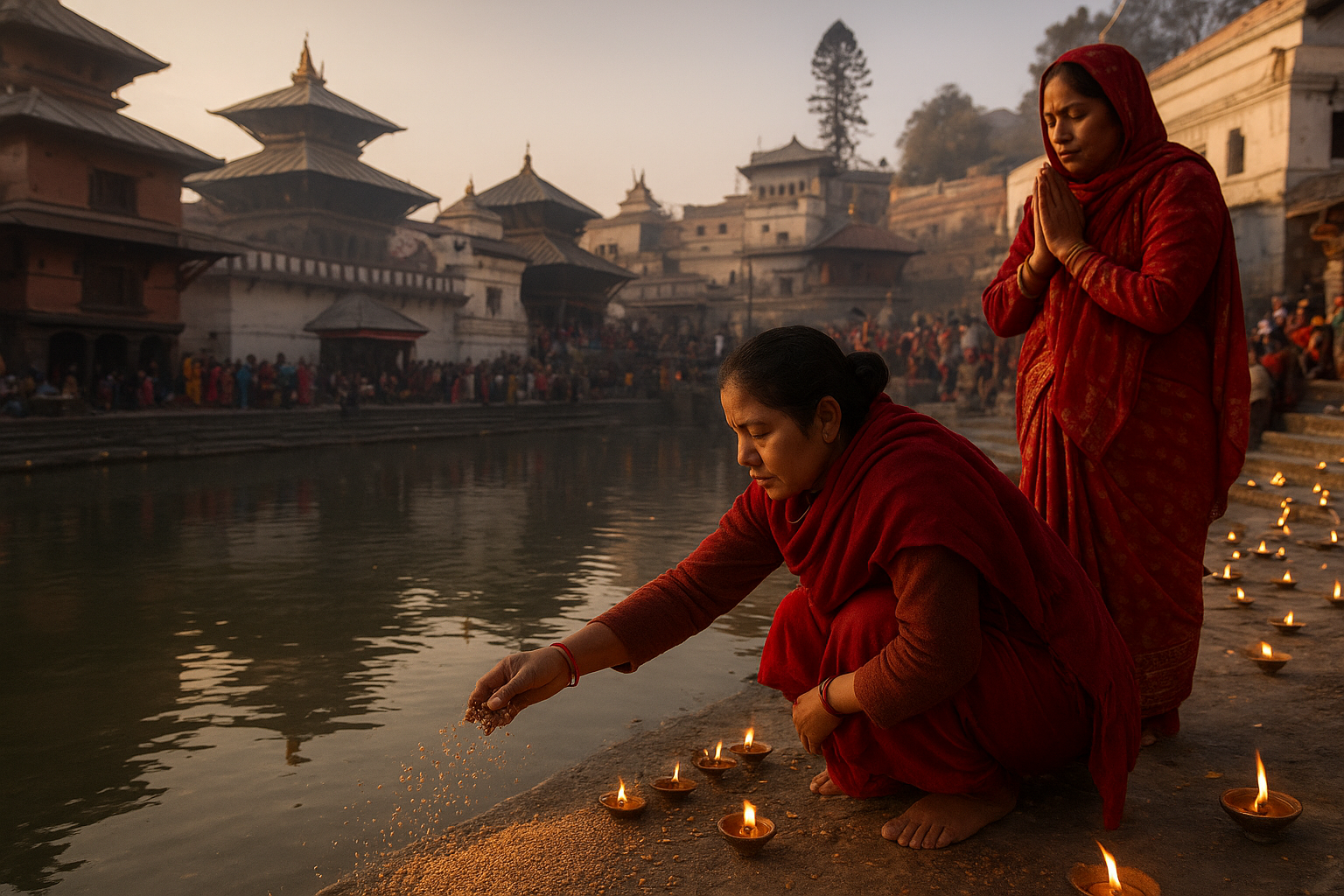Balachaturdashi in Nepal – Honoring Ancestors with Shatabija Seeds at Pashupatinath
Balachaturdashi in Nepal honors ancestors with Shatabija seeds at Pashupatinath, a festival deeply rooted in Hindu tradition and Nepalese cultural heritage. Observed on Krishna Chaturdashi of the Margashirsha month in the Hindu lunar calendar, this festival is dedicated to remembering departed souls and seeking their blessings for the well-being of the family. The name “Balachaturdashi” comes from the ritual of offering Shatabija seeds (hundred-seed grains) to sacred waters, symbolizing life, continuity, and devotion. These seeds are scattered along riverbanks, particularly the Bagmati River in Kathmandu, as an act of homage to ancestors and a prayer for their eternal peace.
Balachaturdashi is not only a ritualistic event but also a spiritual journey that connects individuals with their familial roots and the natural world. Families visit temples, sacred riverbanks, and ancestral shrines, lighting oil lamps, chanting mantras, and performing traditional rites that have been passed down through generations. The festival creates a serene and reflective atmosphere, allowing devotees to meditate on the cycle of life and the enduring presence of their forebears.
Beyond the personal and spiritual significance, Balachaturdashi also serves as a cultural celebration, showcasing Nepal’s rich heritage of art, music, and ritual practices. From the bustling ghats of Pashupatinath to quiet village streams, the festival embodies devotion, tradition, and community, preserving Nepalese identity and ancestral reverence for centuries. It is a profound reminder of the deep connections between the living and the departed, reinforcing values of respect, gratitude, and continuity in Nepalese society.
The Significance of Balachaturdashi
The festival is rooted in the belief that performing rituals for ancestors brings peace to their souls and ensures the well-being of the living. Families remember their departed relatives through prayers, offerings, and symbolic acts that connect them spiritually with the ancestors. Balachaturdashi also emphasizes the importance of gratitude, reflection, and moral responsibility, reminding the living of the cycles of life and death.
Shatabija Seeds Ritual
The hallmark of Balachaturdashi is the scattering of Shatabija seeds, also called “a thousand seeds,” along riverbanks, temple courtyards, and sacred places. The seeds symbolize life, regeneration, and the release of negative energies. Devotees believe that by scattering these seeds, they contribute to spiritual purification and prosperity, while also honoring ancestral spirits.
At Pashupatinath Temple, the rituals are particularly captivating. Early in the morning, families arrive with oil lamps, flowers, and Shatabija seeds. Priests guide them through puja ceremonies, while the devotees recite prayers and mantras for their ancestors. The Bagmati River, flowing beside the temple, is lined with glowing lamps and scattered seeds, creating a serene, almost ethereal atmosphere. The sight is not only visually striking but also spiritually moving, reflecting centuries-old traditions that have been preserved in Nepal.
Cultural Practices and Community Participation
Balachaturdashi is not just a private family ritual—it is a community celebration of remembrance. People from different regions converge at temples and rivers, sharing rituals, stories, and offerings. The festival also inspires acts of charity, as devotees often donate food, clothes, and essentials in the name of their ancestors. The combination of personal devotion and community participation strengthens social bonds and cultural continuity.
Visiting Pashupatinath During Balachaturdashi
For visitors and travelers, witnessing Balachaturdashi at Pashupatinath offers an unforgettable cultural experience. The temple complex, a UNESCO World Heritage Site, becomes alive with spiritual energy. Observers can watch devotees performing rituals, floating oil lamps on the river, and scattering Shatabija seeds—a symbol of respect, remembrance, and hope. The festival offers insight into Nepalese religious practices, family values, and centuries-old traditions that continue to thrive today.
Spiritual and Symbolic Lessons
Balachaturdashi teaches us the importance of honoring our roots, practicing gratitude, and reflecting on life and mortality. The rituals, prayers, and community gatherings emphasize moral values, spiritual awareness, and mindfulness. By participating or observing the festival, one gains not only a cultural experience but also a deeper understanding of Nepalese spirituality.
Conclusion
Balachaturdashi is more than a festival—it is a living tradition that preserves Nepal’s spiritual heritage while celebrating the memory of ancestors. The scattering of Shatabija seeds at Pashupatinath stands as a symbolic gesture of life, renewal, and connection between the living and the departed. Whether you are a devotee or a visitor, experiencing Balachaturdashi offers a profound glimpse into the heart of Nepalese culture and spirituality.






